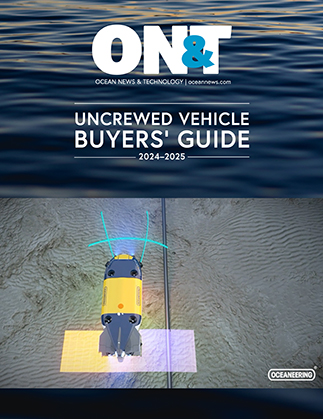Consequently, the utilisation of underwater vehicles for subsea inspection has seen a rapid increase in recent years, as they have been developed to carry out numerous functions and can operate effectively in extreme conditions.
This has introduced significant benefits in terms of efficiency and safety by mitigating the risks associated with deploying human divers into challenging subsea environments. However, underwater vehicles reliant solely on cameras for navigation and inspection frequently prove ineffective in providing adequate situational awareness to their operator, as they fail to capture imagery beyond a few inches in such dark, murky conditions.
SONAR TECHNOLOGY
Sonar technology offers a viable solution to this problem, with its ability to build a picture of underwater environments even when optical visibility is limited. There are three leading options for sonar imaging available on today’s market, the first being side-scan sonar which is employed to detect features on the seabed. Side-scan proves to be a valuable tool for seafloor mapping, making it a popular choice for search and rescue operations and survey applications. Another option is profiling sonar, typically considered the most highly detailed but also the most expensive sonar solution. Profiling sonar employs a narrow beam to create high-definition imagery of the underwater environment.
While this technology can be used to generate excellent 3D reconstructions, it is extremely time-consuming as it takes multiple samples over a small section of the seafloor to build an image. Finally, multibeam imaging sonar uses a wide beam angle to cover a large area, generating results in a fraction of the time a profiling system would and generally retailing at a much lower cost. Multibeam imaging sonars operate by analysing echoes in a 3D volume of water and compressing the data into a single plane to produce real-time 2D imagery.
EFFICIENT 3D RECONSTRUCTIONS
Professor Brendan Englot and PhD students John McConnell and Ivana Collado of Stevens Institute of Technology have designed a unique way of improving underwater situational awareness by building 3D reconstructions with multibeam imaging sonar. Their approach involved mounting two Blueprint Subsea Oculus sonars orthogonally on a Blue Robotics BlueROV2 platform, creating a system that offers an efficient, cost-effective alternative to profiling sonar for generating 3D imagery.
One of the Oculus sonars was dedicated to collecting data on the horizontal plane to measure range and bearing, while the other focused on the vertical plane to assess elevation. The team then fused together the stereo pair of images to build a dense 3D point cloud, enabling them to successfully map a cluttered underwater environment. Professor Englot expressed that the Oculus’ compact form factor was highly beneficial as it meant the pair of sonars could be successfully integrated onto the small inspection-class ROV.
PROVEN IN THE FIELD
The researchers initially used the Stevens Institute Davidson Laboratory high speed towing tank as a proving ground, submerging a custom-made object designed to resemble a blow-out preventer as a target for inspection. Each sonar collected data points from different planar slices and these observations were combined to form a real-time reconstruction of the object in the tank. Following these successful lab tests, the team proceeded to conduct experiments in the field, demonstrating the operational capabilities of their underwater robot in the complex and dynamic setting of a real-world subsea environment.
The ultimate goal was to develop an underwater vehicle with fully autonomous mapping capability and advanced situational awareness. This was achieved by combining the data obtained from the pair of Oculus sonars along with the perceptual algorithms developed by John McConnell during his PHD studies at Stevens Institute. This breakthrough has the potential to revolutionise subsea industries such as offshore wind and fish farming. The development of an affordable, advanced autonomous underwater vehicle (AUV) with the capability to execute complex underwater inspection and maintenance tasks could significantly improve efficiency, safety, and cost-effectiveness across the ocean industries.
In conclusion, sonar technology, particularly multibeam imaging sonar, has emerged as a crucial solution for enhancing situational awareness and underwater imaging. The innovative work carried out by the scientists at Stevens Institute in utilising multibeam imaging sonar in conjunction with advanced perceptual algorithms is a remarkable development. It has the potential to transform the way subsea inspections are conducted through offering a cost-effective, efficient, and safe approach for various industries operating in the underwater environment.
This story was originally featured in ON&T Special Edition 2023. Click here to read more.

